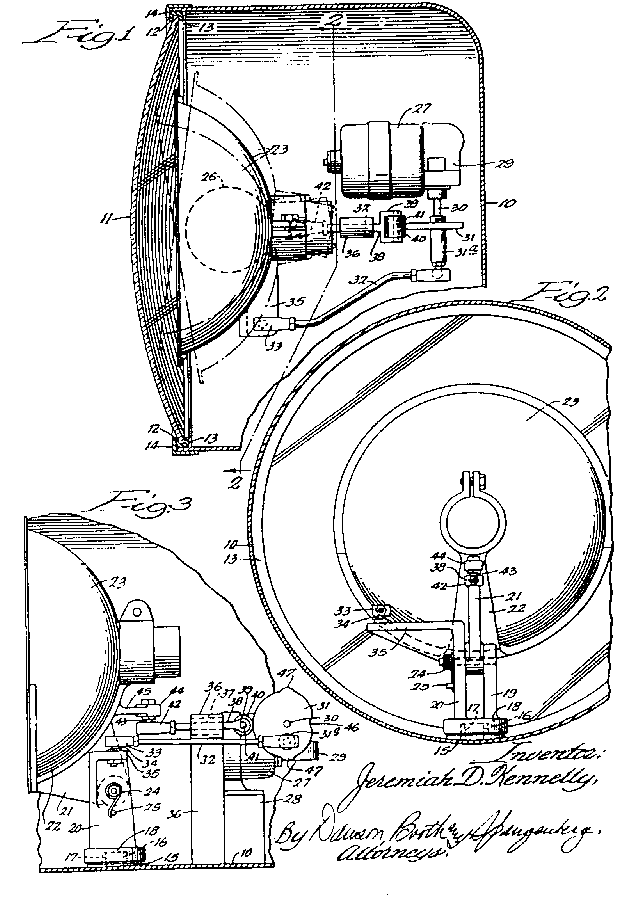This website has been archived from TrainWeb.org/gyra to TrainWeb.US/gyra.
This website has been archived from TrainWeb.org/gyra to TrainWeb.US/gyra.

Figure 1 is a broken transverse sectional view.
Figure 2 is a vertical sectional view taken at line 2 in Figure 1.
Figure 3 is a broken side view in elevation.
Light projecting appartus consists of a casing 10 open at its forward end, the open end
being provided with a transparent plate or lens 11. Supported within the casing 10
on the bottom wall is a base member 15 which is provided with a stud 16 which is
received with a socket 17 provided by a rotatable support member 18.
The support member 18 is equipped with 2 vertically extending standards 19
and 20. Pivotally supported between the standards 19 and 20 is an
elevating arm 21 which merges into laterally extending flanges 22 which are
welded to the light reflector 23. By this means, the reflector 23 is pivotally
supported on swing arm 21 carried by the standards 19 and 20.
A spring 24 encloses the pivot of the swing arm 21 and the free end of the
spring 24 engages a pin 25.
The spring 24 normally urges the arm 21 in a clockwise direction so as to
elevate the reflector 23.
A light bulb 26 is secured within reflector 23.
Motor 27 is provided with reduction gears 29 through which a shaft
30 is driven. Shaft 30 carries a cam 31 onto which is eccentrically
connected a cam arm 31a. The cam arm 31a is
pivotally connected to drive arm 32. Drive arm 32 is equipped with a head
33 which is connected through a ball joint 34 with a laterally extending arm
35 formed integrally with standard 20. When cam 31 is rotated, arm
32 is reciprocated and thereby causes support 18 to oscillate back and forth.
The cam 31 also actuates the swing arm 21 to elevate and lower the reflector
23.
A standard 36 secured to the bottom wall of the casing 10 is provided with a
guide passage 37 at its top for receiving the plunger member 38.
Plunger member 38 carries at its inner end a yoke 39 within which is
mounted a roller 40. Roller 40 is carried by shaft 41 whose ends are
received within the yoke 39.
At its forward end, the plunger 38 is provided with a head 42 secured by a ball
joint 43 to an arm 44 which is connected by web 45 to reflector
23.
Cam 31 is rotated by shaft 30 and by means of its eccentric connection with
arm 32, causes arm 32 to reciprocate and thereby causes the support member
18 to oscillate within the casing 10. Simultaneously, the cam 31 moves
the plunger 38 forward and backward according to the contour of the cam 31, the
spring 24 serving to maintain the roller 40 constantly in engagement with the face
of the cam 31.
The contour of the cam 31 is so designed as to elevate the reflector 23 and to
maintain it in elevated condition while reflector 23 is being swung through one complete
transverse sweep. The cam then permits the reflector 23 to swing downwardly and return
across the transverse path at a lower elevation. To accomplish this, the cam 31 has on one
side a convex face of relatively long radius which, when it engages the roller 40, advances
the plunger 38 and therefore keeps the reflector 23 in a lower poition.
The opposite side of of the cam 31 has a generally convex surface which is of smaller
radius. When this face is brought into contact with roller 40, the spring 24 is
therefore allowed to move the plunger 38 rearwardly and therefore elevates the reflector
23. While in this elevated position, the oscillating arm 32 causes reflector
23 to move laterally across the path.
The elevating face of the cam 31 may be provided with a dip 46 which provides
the shortest radius in the course of the cam 31 and produces a sharp elevation in the light
near the center of the transverse course. Also the ends of the cam 31 may be provided with
outwardly extending ribs or bulges 47 which cause a rapid rising and falling of the reflector
23 near the ends of its transverse stroke where the light makes its sharpest rise and fall.
The cam 31 therefore produces not only a transverse stroke at the bottom and top
portions of the vertical movement, but also accentuates the change in direction of the light, as well as
to the center of its transverse stroke by abrupt changes which therefore bring about a simulation of
the "figure 8" light or similar light ring.
Breaks in the direction of movement enhance the signal effect on the observer.